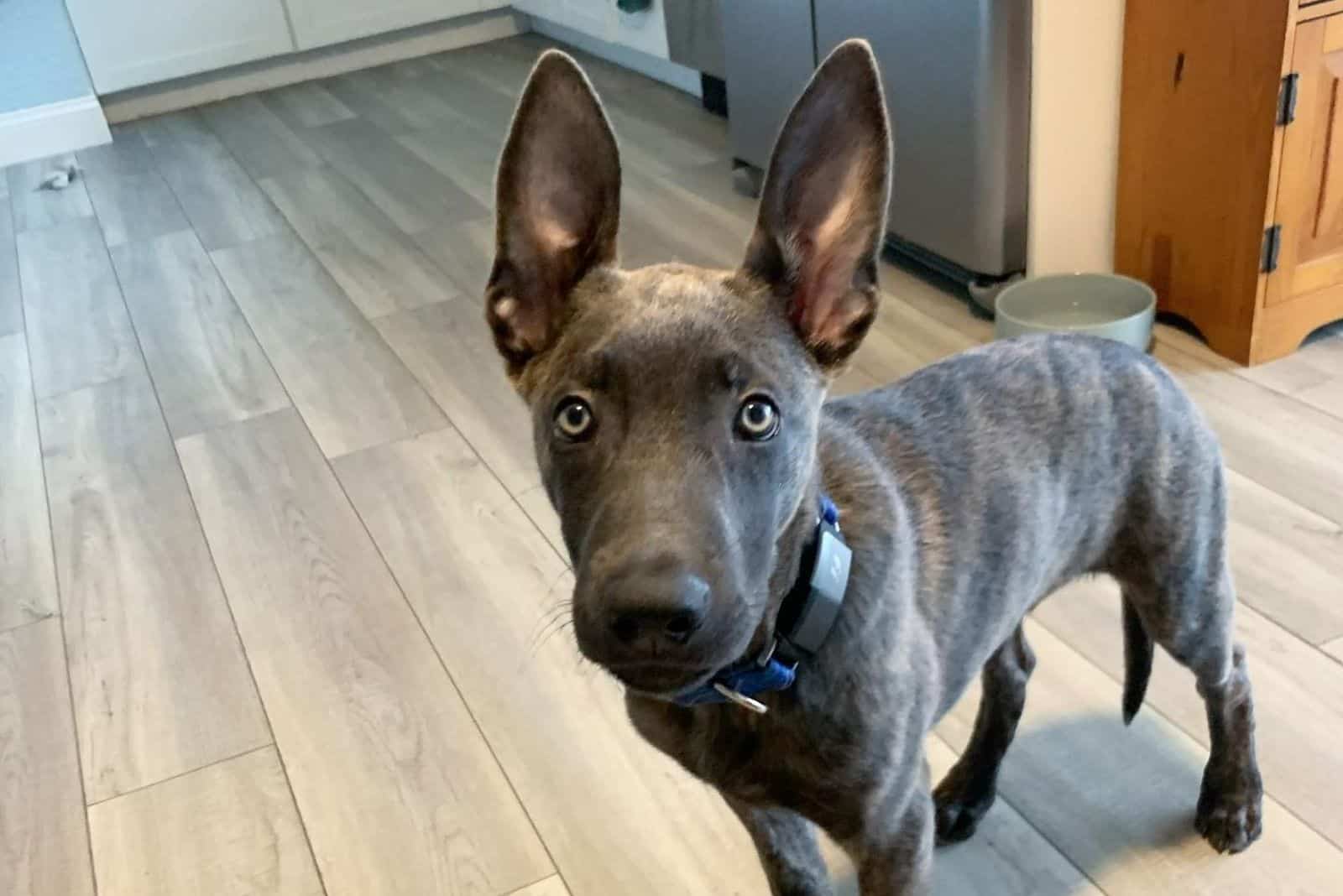Dutch Shepherds are not as common as German Shepherds or Belgian Malinois, but they share many traits with the two dog breeds. If you like some exclusivity when it comes to canine family members, then this is the right dog for you.
In case you need to go a step further, a blue Dutch Shepherd will make it an even bigger eye-catcher. We are going to become canine geneticists for a few minutes, then we will turn back into dog lovers again.
Rest assured, you will know more about blue Dutch Shepherds than you thought you wanted or believed you could. Enough with the chatting, let us get into the topic of the day.
Putting The Blue In The Blue Dutch Shepherd
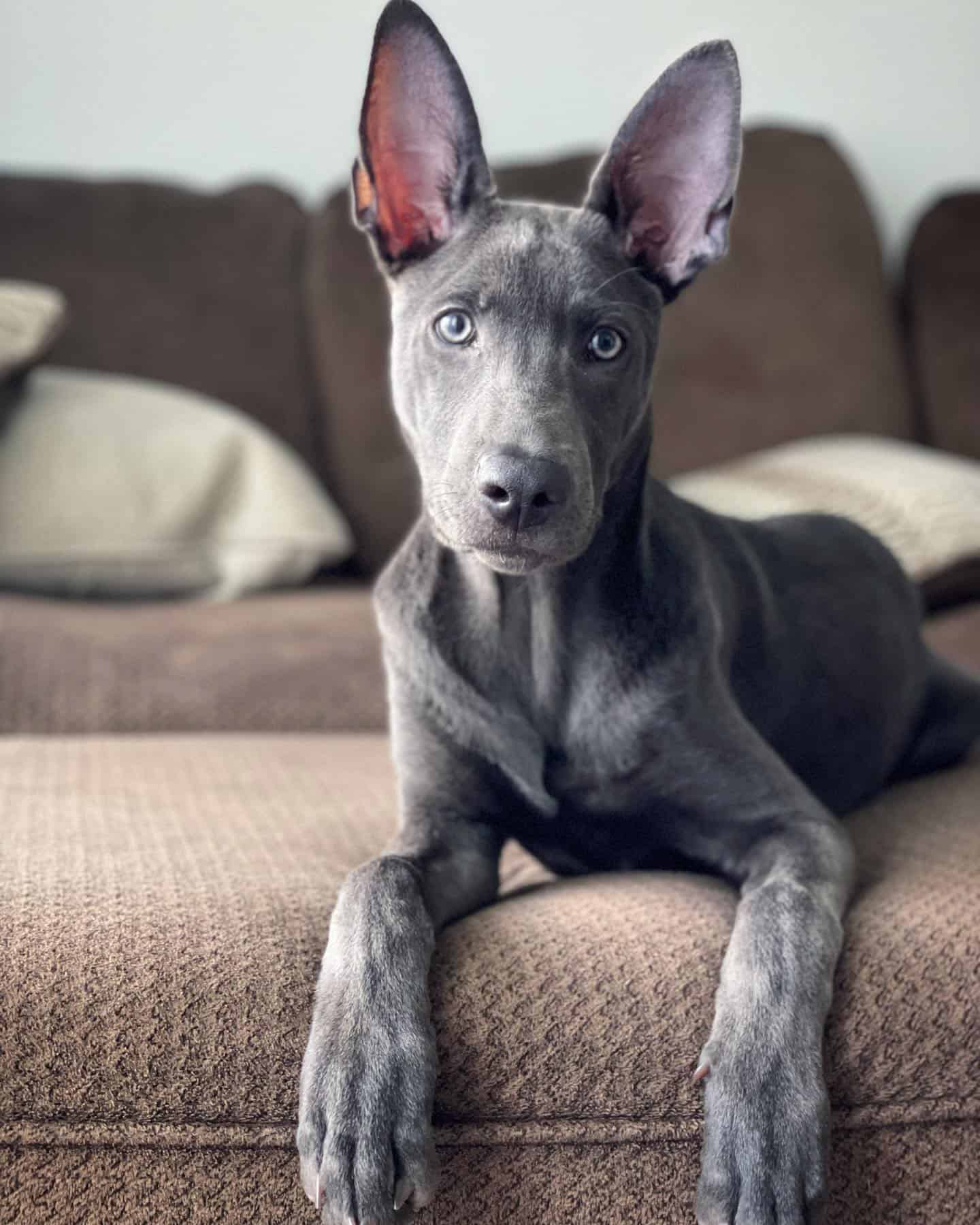
Surely, you already know that the blue coat color is not really blue. Various shades of gray can catch the light in a certain way, causing our human eyes to mistake it for blue.
Breeders simply love to put a hefty price tag on their dogs with unusual colors, so blue is sold by the bucket. Putting that aside, these dogs look absolutely magnificent not only because of the coat color but also the light-colored eyes.
The Dutch Shepherd breed is predominantly silver or gold brindle and yellow. Most Dutch Shepherds have very dark brindling that is barely noticeable due to the similarity between the stripes and base coat color.
With the scarcity of strong Dutch Shepherd bloodlines in the US, the blue color became even more popular, so the pool of breeding stock kept getting smaller. The genetics of a blue Dutch Shepherd is based on breeding generations of dogs with recessive genes.
This phenomenon is not exclusive to the Dutch Shepherd. A blue German Shepherd, Doberman, blue-eyed (and coat) Pitbull, and many more dog breeds have the same genetic process that includes two recessive genes on the D locus.
Such practices are often deemed unethical and a mark of an irresponsible breeder, but the story is not that single-sided. Let us see what the process behind creating a blue Dutch Shepherd is.
The Hierarchy Of Loci Defines A Blue Dutch Shepherd’s Base Coat Color
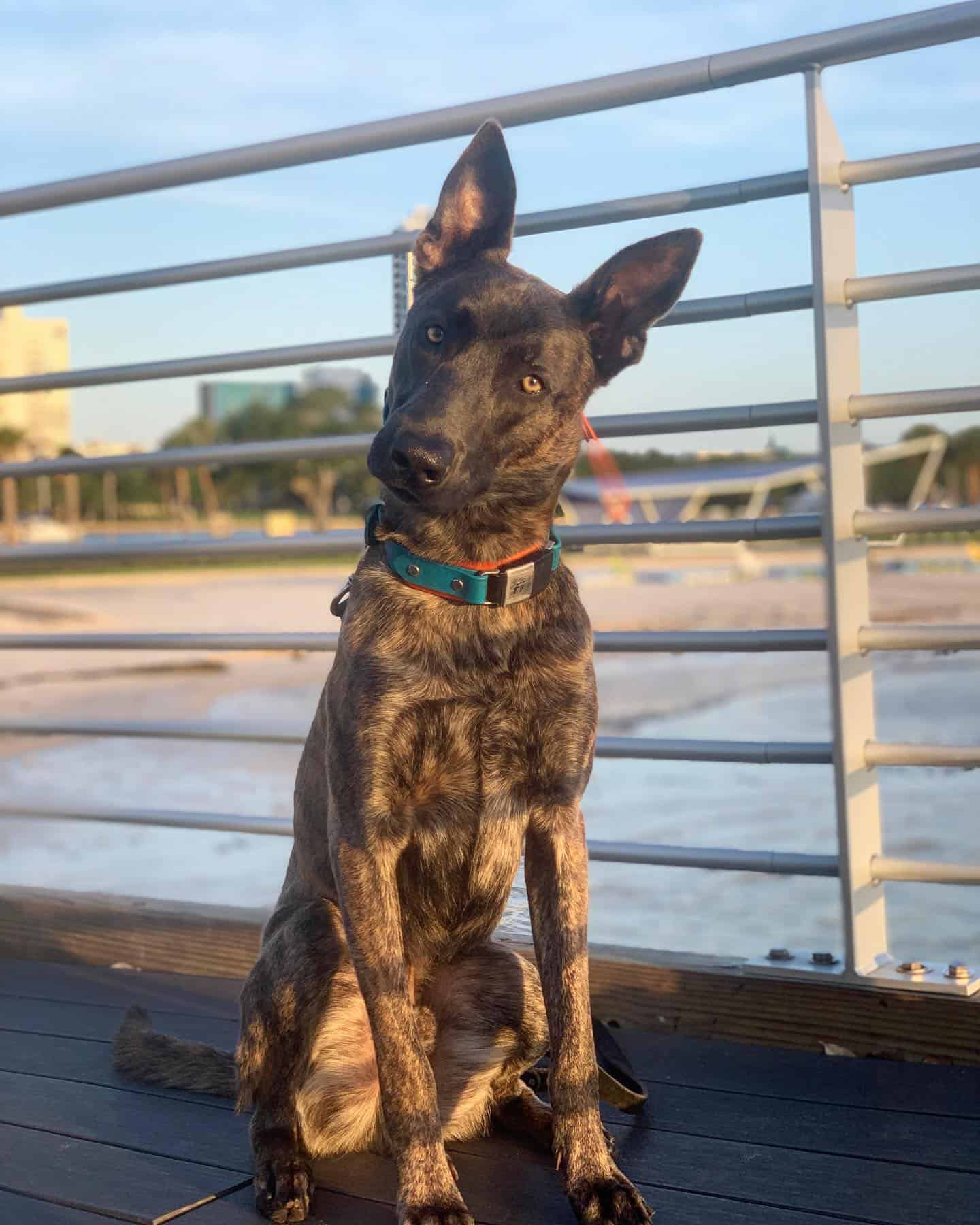
There are two pigments that participate in creating all coat colors — eumelanin (black pigment) and phaeomelanin (red pigment). These pigments are controlled by particular proteins like MC1R, ASIP, and many others to inhibit, stop, or start the production of one of the pigments.
Who gives the instructions to the proteins? That would be the loci or locations on a gene. Each locus has a pair of alleles (gene variations) on it that will express dominant or recessive features.
The first locus that determines whether eumelanin production will be allowed is the E locus. If there are two recessive (e/e) genes on the locus, the dog will be red or yellow. A dominant E/E or dominant and recessive E/e pairing means black pigment production is enabled.
Proceeding to the K locus, two dominant K genes are necessary to continue the black pigment infusion. A pair of Kᴮ or Kᴮ/kʸ alleles will mean the dog will have a black or brown coat.
The K locus interacts with the A, B, and D locus for the next step. The Agouti or A locus controls how much (if any) black or red pigment is produced. It is also responsible for distributing the pigment to particular locations.
In this case, the dominant black from the K locus bypasses the A locus altogether, which means no pattern will be expressed on the dog’s coat. The B locus must have two dominant (B/B) or dominant and recessive (B/b) pairings to express a black base coat.
The blue Dutch Shepherd, obviously, has one of these, but the dilution of black pigment happens when the D locus comes into action. Two recessive genes (d/d) will inhibit eumelanin production, causing the melanocytes (melanin cells) not to create enough black pigment.
Light-Colored Eyes Are A Mystery No Longer
Although the D locus primarily affects coat color, it will also cause the eye, nose, and paw pad color to become diluted. In many cases, a blue Dutch Shepherd will also have light blue, light green, or amber eyes.
The most frequently seen eye color in a blue Dutch Shepherd is light green, by far. Keep in mind that both parents have to have a pair of recessive genes on the D locus for the Dutch Shepherd puppy to express the dilute phenotype (expression of a genotype).
Blue eyes are also seen in dogs that possess the merle gene. However, the presence of the merle gene in Dutch Shepherd dogs has not been encountered yet.
In the case of blue eyes, research led by Embarkvet has shown that a gene called ALX4 that has a part in the maturation of skin and hair follicles followed a DNA sequence duplication that could be the cause of blue eyes in certain dog breeds, like Huskies, Malamutes, etc.
A Blue Brindle Coat Is More Common
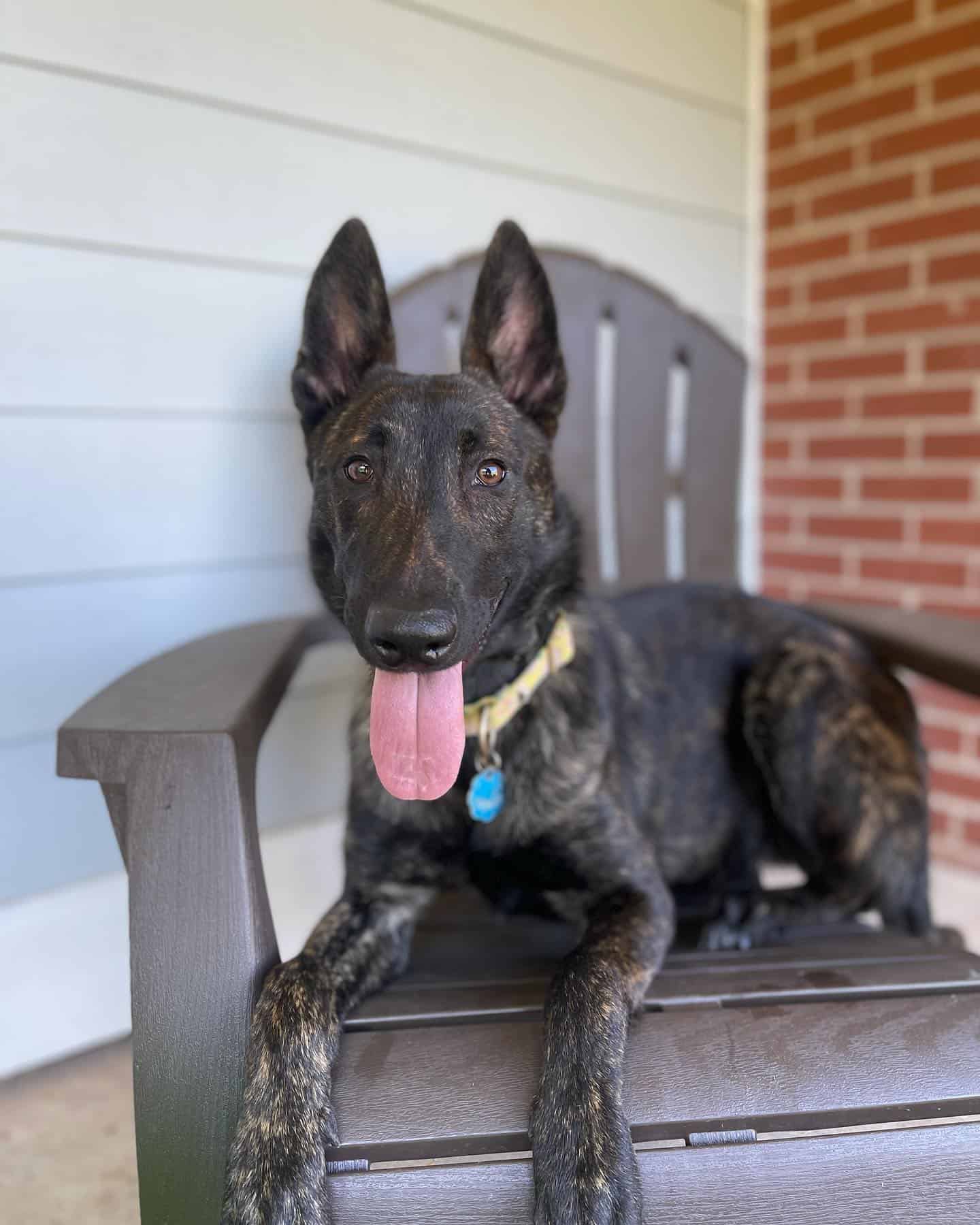
While a fully black Dutch Shepherd becomes a blue Dutch Shepherd with two recessive genes on the D locus, if the K locus has a pair of the second most dominant alleles (Kᵇʳ/Kᵇʳ or Kᵇʳ/kʸ), the brindle pattern will replace the solid black main coat color.
However, the A locus becomes active in this equation. Since it is responsible for pattern creation on a dog’s coat, a particular allele pairing is necessary for the brindling to be expressed. The two dominant genes required are Aʸ/Aʸ.
This double Aʸ gene will create a brindle pattern on the entire body. Another possibility is stomach brindling, but that requires a pairing of Aᵗ/Aᵗ, which is the next dominant gene after Aʸ.
Since brindle is the most common coat pattern found in Dutchies, the stripes will be dark brown, with the main coat retaining the diluted black pigment (blue). The brindling will still be less visible on a blue brindle Dutchie than on a silver or gold brindle dog.
The Blue Dutch Shepherd’s Traits Are Shepherd Dog Standard
Like any shepherd dog, the blue Dutchie excels at herding, service work, and protection. Thanks to its protective instincts, it found a suitable career as one of the go-to guard dogs and police dogs.
Due to the Belgian Shepherd’s bigger breeding pool, there are many more Malinois employed as working dogs, and the Dutch Shepherd is, therefore, more cherished as a show dog. For example, the Royal Dutch Police Dog Association (KNPV) uses Belgian Malinois as police dogs.
The pioneer of non-standard colored breed title winners, the UKC’s first blue Dutch Shepherd breed champion, was Cher Car Kennel’s “I’m Your Blind Spot” dog. This was a short hair Dutchie that took the show dog world by storm.
While these are cute dogs in their puppy form, adults can be very headstrong. They respond great to dog training, but belonging to the herding breeds, they can have a mind of their own. Definitely not first-time dog owner material.
Though loyal to the closest family, they are wary of strangers and are moderately tolerant of children and other dogs. Early socialization is key to raising a well-behaved Dutchie. Do not get surprised if it starts herding everyone into the same room.
For a big dog, the Dutch Shepherd is very playful and can adapt to both house and apartment life. Still, keep in mind they require lots of physical activity, so a large yard or regular trips to the great outdoors are important.
Highly intelligent, the Dutchie will bark only when it is deemed necessary — a great trait for a protective dog. Serious levels of energy require equally big mental stimulation, so be careful not to bore it too much.
A Physique That Speaks For Itself
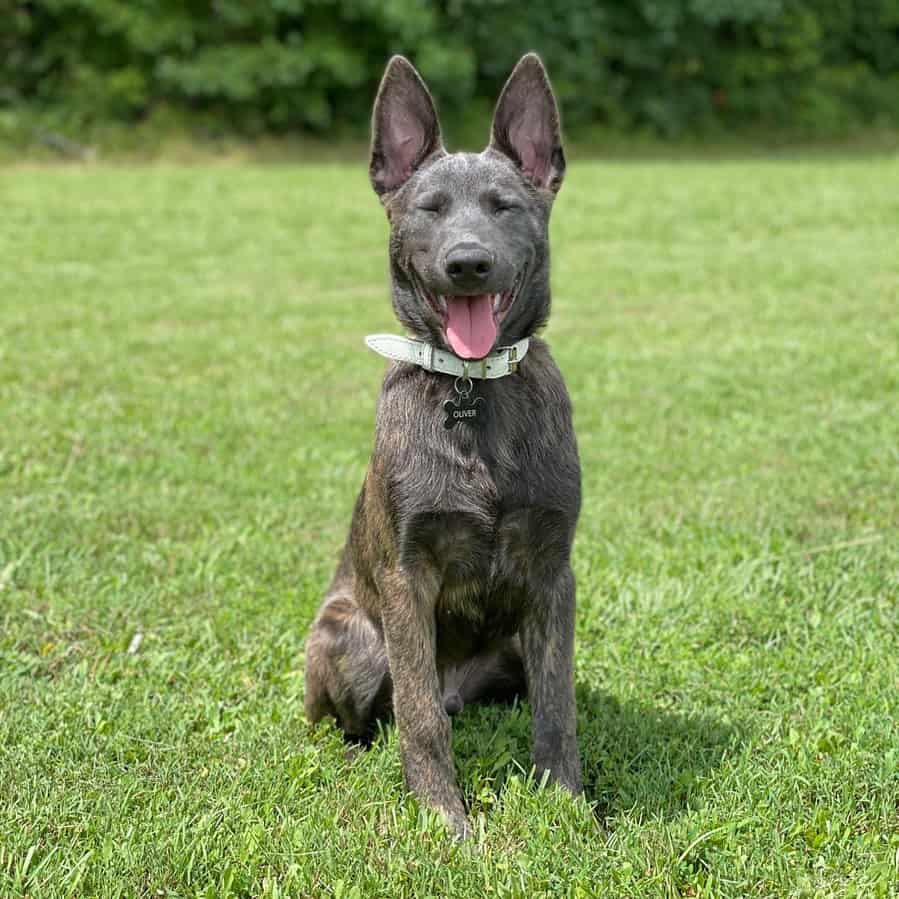
With a body height-to-length ratio of nine to ten, the blue Dutch Shepherd is subtly elongated. This makes for a very athletic and elegant silhouette. All Dutchies grow between twenty-two and a half and twenty-four and a half inches.
On average, they reach weights of forty-two to seventy-five pounds, coupled with well-developed muscularity. A wedge-shaped head has a subtle stop, and the muzzle is longer than the skull.
Only black noses are accepted according to breed standards. Shaped as an almond, the eyes should be dark-colored, with the exception of dogs that express a phenotype of pigment dilution. This means that not every blue Dutch Shepherd will be according to standards.
A pair of forward-facing erect ears that are triangular and on the smaller side make for an alert expression. Ear muscles give the dog high ear mobility.
The neck is muscular but not overly thick and connects to equally toned shoulders. Both front and hind legs sight at a ninety-degree angle to the ground, with a deep-seated chest that reaches almost to the elbows.
Almost perfectly straight, the back is moderately muscular and extends into the long tail that should be straight or slightly curved when the dog is resting.
If a blue Dutch Shepherd has all these traits, then it will be eligible for conformation events. Even though blue is not a standard color, in reality, it is gray (standard), which makes it possible for the dog to be shown.
Coat Quality And Grooming
Both the American Kennel Club (AKC) and the United Kennel Club (UKC) recognize three types of coat in the Dutch Shepherd. There is a short coat, long coat, and rough coat version.
The short-coated Dutchie has a double coat, while the long and rough coat types have a woolly undercoat. The long coat version has hairs that graciously fall straight down and stay very snug with the skin.
Rough-coated Dutchies have very pronounced bushy eyebrows paired with a dense beard and mustache. Such hair distribution makes the rough coat type’s head appear more square than its long and short-haired cousins.
Obviously, these dogs are not the ideal choice for people with dog hair allergies. This is particularly true for the long hair Dutch Shepherd. Short-haired Dutchies only need to be groomed a couple of times per week, but long and rough-coated versions will prove to be a challenge.
The thick undercoat of the rough coat type can be difficult to detangle, so be careful when brushing. Although the long-hair Dutch Shepherd is not that hard to groom (three or four times per week), season seasonal coat changes can be detrimental for those suffering from allergies.
Blue Dutch Shepherd FAQ
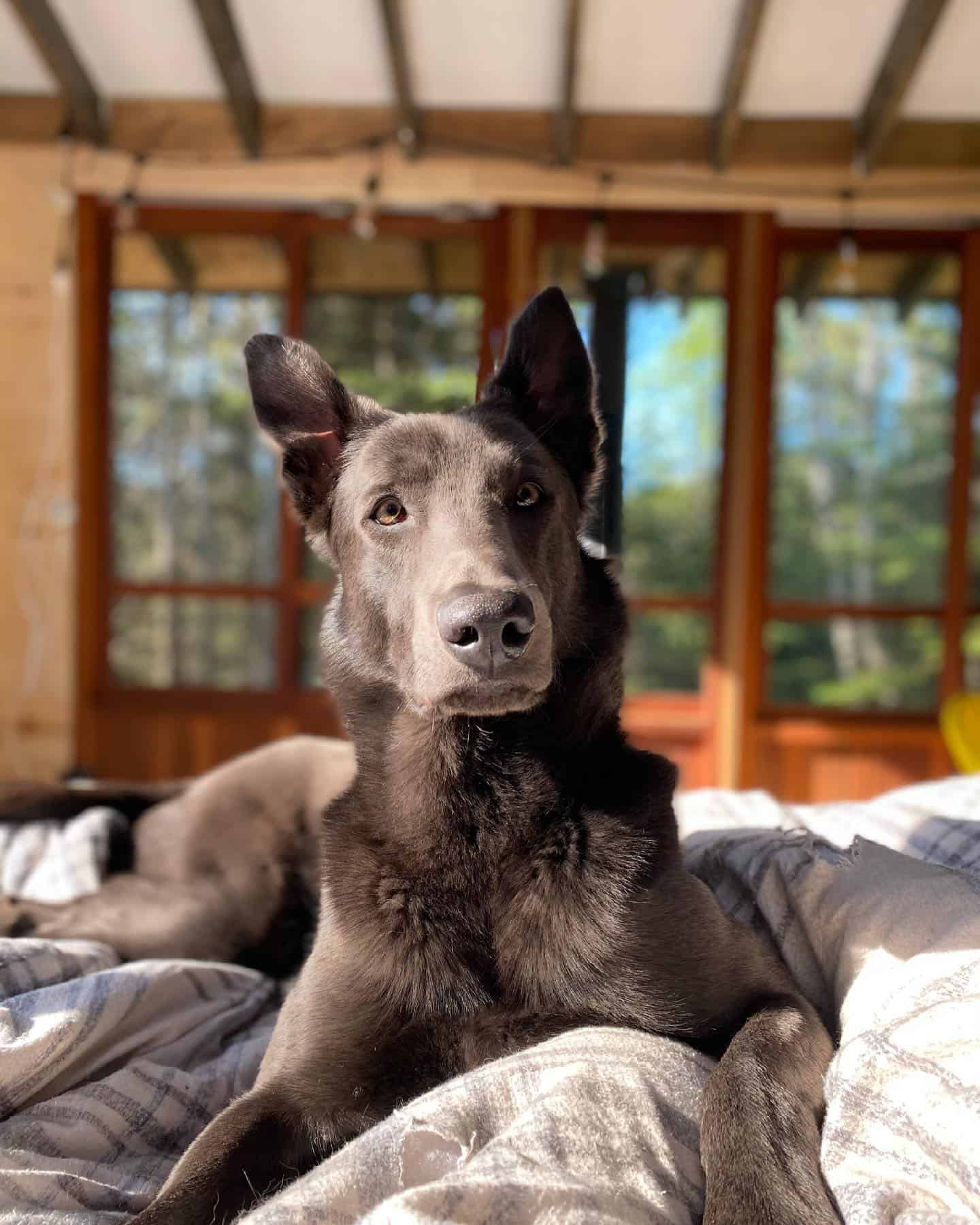
Belgian Malinois were first bred in Belgium, whereas the blue Dutch Shepherd and the non-blue ones were originally found in the Netherlands. Other than the geography of their origin, the two breeds differ in some physical and temperamental characteristics.
The most apparent are coat length and patterns. Dutchies are predominantly brindle and have the three types of coats we discussed a few moments ago. The Malinois only comes with a short coat and sports sable, fawn, mahogany, red, red sable, and fawn sable color and pattern options.
Finding out about other, non-standard colors is always fun, so make sure you have a read of this Belgian Malinois colors breakdown featuring over ten color possibilities.
What can be less obvious is the difference in height. Malinois are taller (twenty-four to twenty-six and a half inches tall) and heavier (sixty to eighty pounds) than Dutch Shepherd dogs.
In terms of temperament, the Belgian Malinois responds slightly better to dog training but barks significantly more than a Dutchie. Also, the Belgian Malinois has somewhat higher energy levels and requires purposeful work at all times. The Dutchie is obviously more laid-back.
Families that consider getting a Belgian Malinois probably wonder whether it is an aggressive dog. We covered that topic in-depth in our article on aggressiveness levels and with eleven facts that potential dog owners should know about the breed’s behavior.
You will also not see a Belgian Malinois litter with a blue puppy in it, as health was the main goal when the Belgian Malinois breeding program was being put together. Check out our Dutch Shepherd vs Belgian Malinois article to find out more about the differences.
Considering that they are a relatively healthy breed, they will live between eleven and fourteen years. If put on a highly nutritive diet and regularly exercised, you can see them live closer to fourteen or even fifteen years of age.
Keep in mind that there are conditions that the Dutch Shepherd dog, in general, is more prone to. These are mostly hereditary genetic diseases that are most commonly found in dogs that were bred without previously clearing DNA tests.
Those include hip and elbow dysplasia, Canine Degenerative Myelopathy, Hypothyroidism, Gonio Dysplasia in the rough coat, Spongy Cerebellar Degeneration in the short coat, and von Willebrand’s in the long-hair type.
Another consideration should be an unexplained sensitivity to certain types of vaccinations and anesthesia. This is something that you should bring up in discussion with a veterinarian.
Conclusion
In the market for beautiful dogs? The blue Dutch Shepherd fits the bill and provides both affection and protection to its family. Ask any Dutchie owner, and you will find countless testimonials of exceptional temperament and physical traits.
We have a list of Dutch Shepherd breeders that should prove to be useful if you want to jump right into purchasing a Dutchie puppy. The legendary Cher Car is among them.
If you want something a little bit bigger and more work-oriented, then take a look at some Malinois puppies or Dobermans. Concentrate on finding the right dog for you and your family, but be warned — herding breeds are high-energy dogs that require a lot of activity.
All this genetics talk got me hungry, so this is where we part ways. Until the next article.
